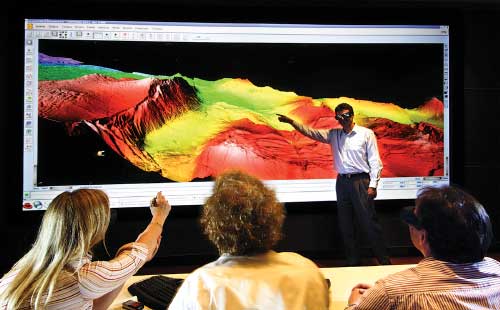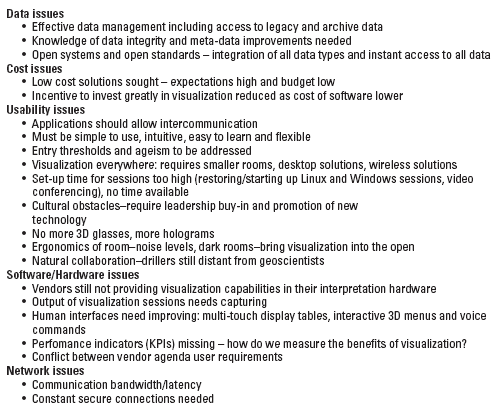Issues and opportunities for collaboration were discussed at a recent conference.
Ruth I. Rusby, Shell International Exploration and Production B.V.
In the rapidly changing visualization world, the future is not just about 3D, as Bill Gates would have it, but is a fully immersive and interactive world that will allow our children to unlock the oil and gas potential in the rock- and fluid-scapes beneath us.
Teams use 3D visualization images to share knowledge or complex data. Clever visualization allows us to see anomalies and attributes in both the subsurface and surface worlds, leading to reduction of uncertainty and a swifter project turn-around. Whether we’re concerned with prospect evaluation, well planning, reservoir engineering or surface facility design, bringing 3D visualization into everyday practice must be a priority.
In the near future, conventional 3D visualization will focus on higher resolution and improved image quality. Blending techniques will improve, and future digital projectors will be brighter and cheaper. Auto-stereo techniques are improving, though most of these are suitable for one viewer only, and the collaborative element is missed. Desktop technology used to drive visualization will become easier to use. Graphics cards will become faster and computer memory cheaper. Advances in video compression mean that remote working and virtual collaboration between sites working together on large integrated data sets will become more viable. But what do we need to achieve a step-change in visualization by 2020; what is revolutionary now? Will touch screens, gesture control and holograms get us there?
 |
|
“Be seduced by the increased understanding you extract from the data, not the pretty pictures.”
|
|
“By 2020 we’ll all have a 3D television at home,” says Tamas Forgas of Holografika, “and we’ll have as much image depth as we want.” Holografika is working on a unique approach to 3D visualization by attempting to display quasi-holographic images. The light field emitted by a large number of projectors is used to create a 3D view without using glasses, likened to looking through a window. This interesting technology requires rendering 60-70 times that which is required in a native 2D view and requires a large rendering cluster to drive the display. Today’s displays are not good enough to compensate the need for glasses, but the potential is there. Touch screen technologies and mouse/sword controls are being investigated to allow a more natural user interface and greater immersion in virtual worlds.
Whether future virtual worlds will be stereoscopic, auto-stereoscopic or truly 3D holographic is open for debate. Certainly in the automobile and medical industries, there are real benefits to be derived from working with true holographic displays. However, the depth of field obtainable with active shutter glasses or Infitec (interference filter technology) has yet to be achieved elsewhere.
It is anticipated that 3D displays will reshape work processes. However, they must nevertheless be intuitive, flexible and easy to use to allow them to slip from the specialist field into our everyday environment, where “staff are reluctant to divert from familiar and trusted work practices,” says Earl Dodd, IBM Deep Computing Group.
So what’s stopping us from moving forward in terms of true collaboration, immersion and interaction with complex 3D data, and what issues do we still have to resolve? At the World Oil Visualization Preview Showcase in May 2007, a working session was held in which participants were asked to highlight opportunities and issues faced. Over 100 participants took part in this exercise and some of the main concerns emerging from this can broadly be grouped into five categories: data, cost, ease of use, software/hardware, and network issues. More specifically, the concerns in Table 1 were raised.
| TABLE 1. Issues and opportunities |
 |
|
It appears that to see the future more clearly, we first need to remove the “fog” of rather mundane issues that continue to cloud our view. Day to day visualization beyond 2D is still not a reality. Management buy-in is not apparent or convincing enough to make it so. Software still doesn’t provide sufficient visualization capabilities and business benefits of visualization are not being captured and made obvious. “Choose tools carefully,” said Paul Morin, USGS, “and be seduced by the increased understanding you extract from the data, not the pretty pictures.”
To achieve breakthrough performance, it is not enough to simply do what we do now only faster. In practice, we know it is difficult to create a high-fidelity virtual reality experience due to technical limitations on processing power, image resolution and communication bandwidth. In order for the worlds of virtual collaboration, high-resolution stereoscopy, touch screen or sword-like interfaces, and even holography to converge, we need to clear the debris along our path to our vision of the future. Only then can the next generation reasonably expect high-resolution 3D desktops and 3D rooms, available to all, with full immersion and interaction control; only then we will be truly able to bring the remote expert skills to projects on demand. 
|
THE AUTHOR
|
|
|
Ruth Rusby is Virtual Reality Geoscientist for Shell International Exploration and Production. She earned a degree in geology from St. Andrews University, Scotland, and holds a PhD in marine geology and geophysics from Durham University, England. She has worked in 3D visualization, seismic interpretation, operations geology, shallow hazard surveys and marine geology and geophysics. Ruth is a mother of three, now living in Rijswijk, the Netherlands, after recent spells in Malaysian Borneo and Australia.
|
| |
|





